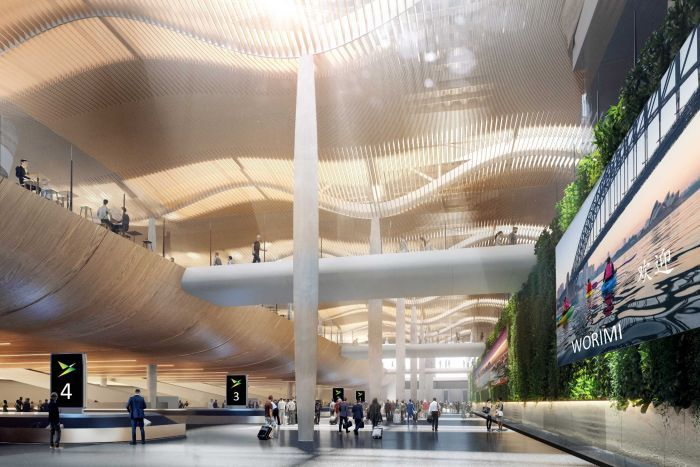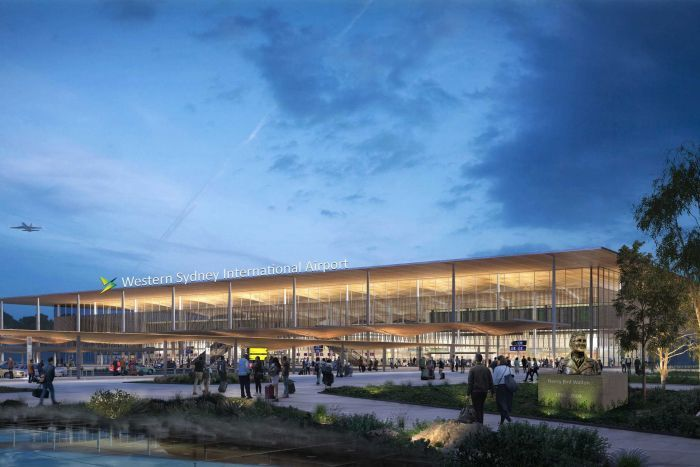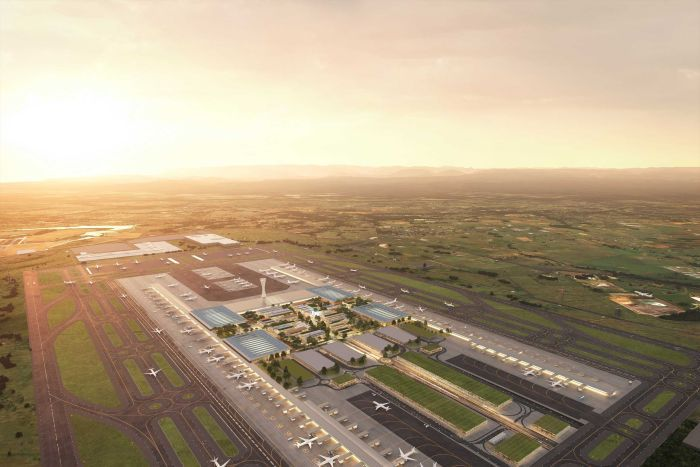Recently, Australia's Prime Minister Scott Morrison was reported as saying WSIA is "set to be the largest gateway to Australia", with completed airport designs "another step to making it a reality".
Artist's impressions of the terminal design, by Zaha Hadid and Cox Architects, appear below.
The design features landscaped gardens and a public plaza, as well as dining, retail and entertainment areas with timber ceilings and vertical gardens that were, according to Cox Architecture's project director David Holm, inspired by "the unique local flora of western Sydney and the great Australian light to create an unmistakable regional identity".


 Sources: ABC Australia
Sources: ABC Australia
Mr Morrison's comment requires examination.
"The largest gateway to Australia"? Presumably that does not mean in terms of physical size but by passenger numbers. The busiest Australian airport is Sydney (Kingsford Smith), with 44.4 million passenger throughput in 2018 and probably the same this year, followed by Melbourne Tullamarine on 37 million and again heading to be much the same in 2019.
The way in which the nature of WSIA has changed is underlined by anticipated passenger numbers.
Back in 2013, three years before the government signed off the project, the NSW Business Chamber released an economic report examining three growth scenarios for the airport. It was envisaged that it could begin operations in 2027 with three million passengers per annum, then expand in phases to seven million in 2033, then make a big leap to 22-30 million in 2040 and up to 33 million by 2050. That would still leave it more than 10mppa short of Sydney Airport's current totals (which are expected to rise to 70 mppa by 2030), although some of that traffic would transfer to WSIA.
It is only since 2015 that the scale of this project - to which have since been added an 'airport city' and assorted new rail lines and road access - has increased, and it did so exponentially.
It was then that the concept of a dual-parallel 3700m runway system was introduced, allowing the airport to handle approximately 80 million passengers per annum by 2050 - well over twice the estimate made only two years earlier.
To put that into perspective, it is what London Heathrow handles now. Much of that increase was predicated on terminal design to handle multiple A380s, A380s being aircraft that are in fact now heading towards the autumn of their lives.
The other change is in the nature of the traffic. WSIA was initially envisaged as a reliever airport, focused on low cost operations, and specifically targeting the sprawling western Sydney suburbs and their inhabitants.
Again, it was in 2015 that a sea change took place, when the government determined that WSIA would be "a primary airport of Western Sydney - not just low-cost but also premium". And there is nothing in the photos above that suggests 'low cost'.
But building WSIA just for 'low cost' was never a starter anyway.
Less than a fifth of Sydney Airport's capacity is on budget carriers and Australia's ratio of low cost seat capacity generally is less than that of many other developed nations: 14.2% for international flights and 25.6% for domestic.
Sydney Kingsford Smith Airport seats by business model, week commencing 28-Oct-2019
 Source: CAPA - Centre for Aviation and OAG
Source: CAPA - Centre for Aviation and OAG
So, what is coming Western Sydney's way is a large, purpose-built domestic and international airport - shiny, bright and environmentally friendly, with attached business and commercial areas; a new city in a city.
Often when this stage is reached, though, that is when the problems start. When residents begin to realise that the convenience of local flights might be negated by 24-hour operations by large jets.
The Blue Mountains Mayor, Mark Greenhill, who is a frequent critic and is but one to express concern, has noted that what nearby residents "want to know is where the planes are going to fly, not what the terminal looks like". He has urged the Australian Government to advise flight path designs, which are not expected to be released until 2021. There is no obvious reason why such paths cannot be advised when artists' impressions show exactly where the runways will be.
Not to release such information, and to advise how noise regulations will be introduced and managed, is a lesson some airport operators have learned painfully.
Sydney Airport relinquished its opportunity to be the preferred operator of WSIA, which is being constructed as a public sector project with the prospect of inviting private sector involvement at a later date.
Private investors might be better advised themselves to adopt a 'wait and see' approach.